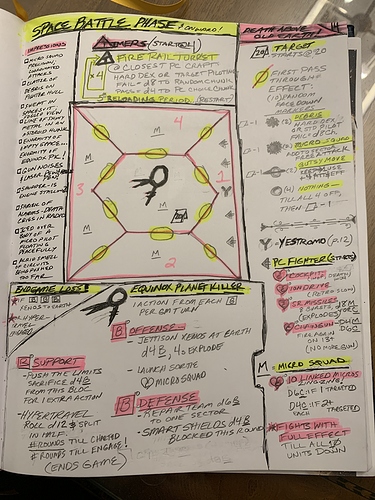Yep yep.
That’s why I feel HF’s call to do 5 and 10 point chunks was so inspired…
Effectively, you have this as a framework:
1-9 Effort
-Simple effort tasks. Easy and quick.
- Weak sauce mooks that have to mob up to be a Heart.
10 Effort (1 Heart)
-average tasks that are either difficult or time consuming, but rarely both
-Normal 1 Heart PCs and Foes
-a weak human who can’t operate independent of their battle suit (ie a single 5HP Chunk) can make a weak human into an average Human
-similarly, there’s times I would consider a well armored or especially powerful Mook Mob to be a 5 point Chunk as well
20 Effort
-an especially tough, moderately time consuming task for a single average human
-Two average Humans or Foes
-A single 2 Heart Heart Human or Monster
-An average 1 heart Human and the untrained rabble he’s whipped into a 1 heart mob
-an average human who can keep fighting even if Battlesuit gets trashed
30 Effort
-A Very difficult, very time consuming problem to solve or chest to open for the average human
-3 average humans
-2 average humans and a Mob, or 2 Mobs and an average Human
-a badass 2 heart Human in a Battle suit they can keep fighting after it’s trashed
-an average Human manning a single 10 point Chunk Souped-up Car
50 Effort
-Extremely difficult, time consuming challenge, or series of pretty tough challenges
-(Here’s where I start adding in:) single 5 point Bloc, like in the examples in very top post
100 Effort
-one average dude just ain’t gonna solve this problem, unless mayyyyybe if they have Days to Years to work on it. Or if they figure out the secret weakness. Or assemble the right tools and allies (and plenty of ‘em!). But even then… probably gonna be tough.
-10 Battle Robots (5 point chunks)
-… insert various other mixes here…
-1 10 point Bloc
150+ Effort
Bigger and bigger honkin problems! We’re talking Mythic “Labors of Hercules” level here!
Incidentally, this talk isolating to just the Effort needed to overcome a problem highlights how elegant the balance is with which Effort dice you get to roll. And even more crucial: the same amount of effort distributed across more foes means they get actions against PCs. Ditto if you give a single foe more than one action, it really matters as to how dangerous an encounter can be regardless of number of HP! And don’t get me started on the Timer/Effort relationship! Man this game is so frickin deep and cool!


